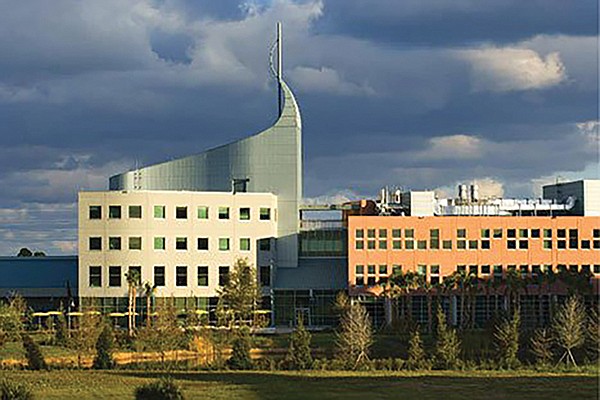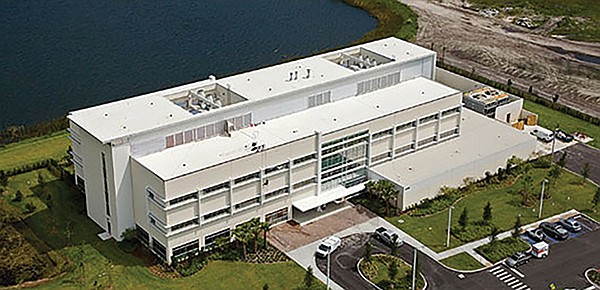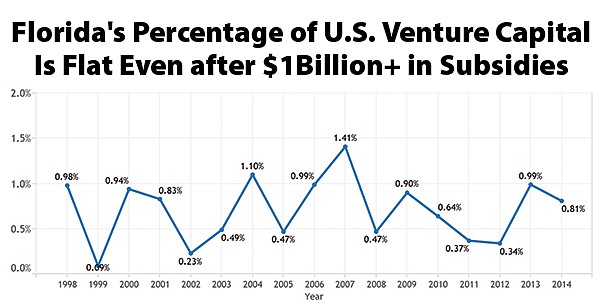 Facebook
Facebook
 X
X
 Instagram
Instagram
 TikTok
TikTok
 Youtube
Youtube

In October of 2003, governor Jeb Bush of Florida revealed a $500 million spending plan (later expanded to almost $600 million) to bring San Diego–based Scripps Research Institute to Palm Beach County as a launching pad for a statewide biotech hub that would generate 50,000 jobs in 15 years.
Florida has shelled out $1.3 billion in state, county, and city subsidies to the biotech industry, according to Reuters, in the effort to woo biotech to the Sunshine State.


Two other San Diego biomedical research facilities opened branches in Florida: Sanford-Burnham Medical Research Institute in the Orlando area and Torrey Pines Institute for Molecular Studies in Port St. Lucie. By May of 2011, the subsidies were costing Florida $1 million per job created at Scripps and Sanford-Burnham and a hair below that at Torrey Pines. (Now the tab is still almost $1 million per job at Scripps and well above that at Torrey Pines.)
According to Washington, DC’s Good Jobs First, a think tank battling against corporate welfare, Scripps remains Florida’s largest recipient of subsidies for all kinds of enterprises, with Sanford-Burnham third, and Torrey Pines eighth.
Bush’s idea was that emerging biotech companies would sprout out of the research facilities and attract ancillary businesses — law firms, retailers, medical centers, et cetera.
Now Jeb Bush is running for president and is hanging his campaign on his economic record in Florida. “We made Florida number one in job creation and number one in small business creation — 1.3 million new jobs, 4.4 percent growth, higher family income,” he boasts.

His competing Republican candidates should easily deflate such claims, because when the 2007–2009 Great Recession hit, just after Bush left office, the Miami-Dade County area got walloped, as did real estate and other industries throughout the state. Florida has always had a boom/bust economy, and Bush was lucky enough to be in office as the bubble was inflating and gone when the bubble burst.
If fellow Republicans won’t shoot down Bush’s dubious claims, Democrats will. Representative Debbie Wasserman Schultz, a Florida Democrat, points out not only that the biotech program has failed economically but a part of Bush’s deal was giving Scripps exemption from key parts of the state’s public records law.
Bush’s strategy for building a state biotech lodestar has definitely fizzled. In May, Joe Cortright, an expert in city planning, wrote a piece for CityObservatory.org. The title: “Florida’s Biotech Bet.” The gist: Florida lost the wager. There has been “little evidence of progress,” says Cortright’s story.
In 2002, Cortright had been with the Brookings Institution. He and another researcher had studied the geographic distribution of the biotech industry in the U.S. “The industry’s economic impact [is] tightly concentrated in just a few leading centers,” wrote Cortright in the CityObservatory.org essay. Those centers are San Diego, San Francisco, and Boston. Now, 13 years later, those three centers are even more dominant. In 2000/2001, the three centers attracted 54 percent of the venture capital going into biotech. In 2010/2012, that concentration had gone up to 60 percent.
And Florida? Since 1998, it has received about 1 percent of the national venture capital going into biotech. In 1998, Florida got .98 percent of national biotech capital. In 2014, it was .81 percent. More than a billion dollars have been dumped into the pot, and the percentage has declined.
I interviewed Cortright. He said that even “after the establishment of Scripps, Sanford-Burnham, and Torrey Pines, Florida has not received a higher percentage of venture capital money than it did 15 years ago.”
He added, “For places like Florida, it is less than a zero-sum game. The biotech industry is highly clustered in [San Diego, San Francisco, and Boston]. There are powerful business advantages” in those locations — clusters of lawyers, financial personnel trained in biotech, accountants that understand the business, and the like. “Florida is still a backwater for biotech, particularly for the commercialization” of discoveries, according to Cortright.
Florida appears to have misjudged the amount of work involved in commercialization, said Reuters in the story this March. Only six companies have spun out of Scripps. One no longer operates and only two remain in the state. “When the governor went after these institutes to come to Florida, we didn’t realize the amount of infrastructure that needed to be in place,” Kelly Smallridge, president of Palm Beach County’s Business Development Board, told Reuters.
Florida’s Office of Economic and Demographic Research concedes that the state’s Innovation Incentive Program, set up in Bush’s second term, has not broken even. The goals of the program “result in a relatively low [return on investment],” said the office in a report last year. One reason is that research and development has a smaller multiplier, or ripple effect, than other kinds of industries.
The name “Sunshine State” has hardly applied to Florida’s standards of transparency and accountability in the subsidy programs. The sunshine exemptions for Scripps set the tone. Long after Bush had left office, there were reforms, but questions linger. According to the Florida Center for Fiscal and Economic Policy, the state released some information for the years 1995–2011, and the report showed that the state had promised to create 224,000 jobs (in biotech and other industries) and delivered only 86,284 jobs. As of mid-2010, biotech had created 900 of the 2033 jobs promised.
In late 2011, the center concluded, “Florida’s tax and budget policies are riddled with subsidies and other benefits extended to a select group of businesses in the state. The current system provides little or no review of these policies.” The center called for “more transparency, more accountability.”
In 2013, in response to the pressure, a state website provided more information to taxpayers. Last year, the legislature passed a law requiring the Office of Economic and Demographic Research and the Office of Program Policy Analysis and Government Accountability “to evaluate all economic development subsidy programs every three years,” according to Good Jobs First.
“The transparency of the programs is better than it was before,” said Kasia Tarczynska, research analyst at Good Jobs First, in an interview. Also, the state is doing “smaller deals,” not the Scripps-size ones. But the reforms were made long after Bush left office.


In October of 2003, governor Jeb Bush of Florida revealed a $500 million spending plan (later expanded to almost $600 million) to bring San Diego–based Scripps Research Institute to Palm Beach County as a launching pad for a statewide biotech hub that would generate 50,000 jobs in 15 years.
Florida has shelled out $1.3 billion in state, county, and city subsidies to the biotech industry, according to Reuters, in the effort to woo biotech to the Sunshine State.


Two other San Diego biomedical research facilities opened branches in Florida: Sanford-Burnham Medical Research Institute in the Orlando area and Torrey Pines Institute for Molecular Studies in Port St. Lucie. By May of 2011, the subsidies were costing Florida $1 million per job created at Scripps and Sanford-Burnham and a hair below that at Torrey Pines. (Now the tab is still almost $1 million per job at Scripps and well above that at Torrey Pines.)
According to Washington, DC’s Good Jobs First, a think tank battling against corporate welfare, Scripps remains Florida’s largest recipient of subsidies for all kinds of enterprises, with Sanford-Burnham third, and Torrey Pines eighth.
Bush’s idea was that emerging biotech companies would sprout out of the research facilities and attract ancillary businesses — law firms, retailers, medical centers, et cetera.
Now Jeb Bush is running for president and is hanging his campaign on his economic record in Florida. “We made Florida number one in job creation and number one in small business creation — 1.3 million new jobs, 4.4 percent growth, higher family income,” he boasts.

His competing Republican candidates should easily deflate such claims, because when the 2007–2009 Great Recession hit, just after Bush left office, the Miami-Dade County area got walloped, as did real estate and other industries throughout the state. Florida has always had a boom/bust economy, and Bush was lucky enough to be in office as the bubble was inflating and gone when the bubble burst.
If fellow Republicans won’t shoot down Bush’s dubious claims, Democrats will. Representative Debbie Wasserman Schultz, a Florida Democrat, points out not only that the biotech program has failed economically but a part of Bush’s deal was giving Scripps exemption from key parts of the state’s public records law.
Bush’s strategy for building a state biotech lodestar has definitely fizzled. In May, Joe Cortright, an expert in city planning, wrote a piece for CityObservatory.org. The title: “Florida’s Biotech Bet.” The gist: Florida lost the wager. There has been “little evidence of progress,” says Cortright’s story.
In 2002, Cortright had been with the Brookings Institution. He and another researcher had studied the geographic distribution of the biotech industry in the U.S. “The industry’s economic impact [is] tightly concentrated in just a few leading centers,” wrote Cortright in the CityObservatory.org essay. Those centers are San Diego, San Francisco, and Boston. Now, 13 years later, those three centers are even more dominant. In 2000/2001, the three centers attracted 54 percent of the venture capital going into biotech. In 2010/2012, that concentration had gone up to 60 percent.
And Florida? Since 1998, it has received about 1 percent of the national venture capital going into biotech. In 1998, Florida got .98 percent of national biotech capital. In 2014, it was .81 percent. More than a billion dollars have been dumped into the pot, and the percentage has declined.
I interviewed Cortright. He said that even “after the establishment of Scripps, Sanford-Burnham, and Torrey Pines, Florida has not received a higher percentage of venture capital money than it did 15 years ago.”
He added, “For places like Florida, it is less than a zero-sum game. The biotech industry is highly clustered in [San Diego, San Francisco, and Boston]. There are powerful business advantages” in those locations — clusters of lawyers, financial personnel trained in biotech, accountants that understand the business, and the like. “Florida is still a backwater for biotech, particularly for the commercialization” of discoveries, according to Cortright.
Florida appears to have misjudged the amount of work involved in commercialization, said Reuters in the story this March. Only six companies have spun out of Scripps. One no longer operates and only two remain in the state. “When the governor went after these institutes to come to Florida, we didn’t realize the amount of infrastructure that needed to be in place,” Kelly Smallridge, president of Palm Beach County’s Business Development Board, told Reuters.
Florida’s Office of Economic and Demographic Research concedes that the state’s Innovation Incentive Program, set up in Bush’s second term, has not broken even. The goals of the program “result in a relatively low [return on investment],” said the office in a report last year. One reason is that research and development has a smaller multiplier, or ripple effect, than other kinds of industries.
The name “Sunshine State” has hardly applied to Florida’s standards of transparency and accountability in the subsidy programs. The sunshine exemptions for Scripps set the tone. Long after Bush had left office, there were reforms, but questions linger. According to the Florida Center for Fiscal and Economic Policy, the state released some information for the years 1995–2011, and the report showed that the state had promised to create 224,000 jobs (in biotech and other industries) and delivered only 86,284 jobs. As of mid-2010, biotech had created 900 of the 2033 jobs promised.
In late 2011, the center concluded, “Florida’s tax and budget policies are riddled with subsidies and other benefits extended to a select group of businesses in the state. The current system provides little or no review of these policies.” The center called for “more transparency, more accountability.”
In 2013, in response to the pressure, a state website provided more information to taxpayers. Last year, the legislature passed a law requiring the Office of Economic and Demographic Research and the Office of Program Policy Analysis and Government Accountability “to evaluate all economic development subsidy programs every three years,” according to Good Jobs First.
“The transparency of the programs is better than it was before,” said Kasia Tarczynska, research analyst at Good Jobs First, in an interview. Also, the state is doing “smaller deals,” not the Scripps-size ones. But the reforms were made long after Bush left office.
Comments